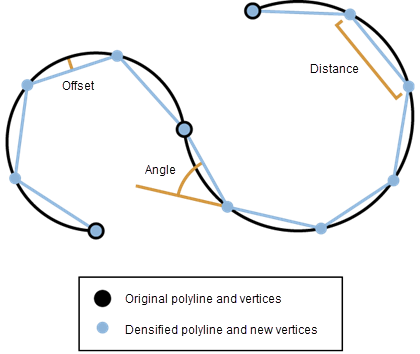| Label | Explanation | Data Type |
Input Features | The polygon or line feature class to be densified. | Feature Layer |
Densification Method (Optional) | Specifies the feature densification method to be used.
| String |
Distance (Optional) | The maximum distance between vertices. This distance will always be applied to line segments and to simplify curves. The default value is a function of the data's x,y tolerance. New vertices may not be inserted at this exact interval along the line, rather they will be inserted within this distance of the previous vertex. There is no way to ensure that a vertex is added exactly at the specified interval along the line segment. | Linear Unit |
Maximum Offset Deviation (Optional) | The maximum distance the output segment will be from the original. This parameter only affects curves. The default value is a function of the data's x,y tolerance. | Linear Unit |
Maximum Deflection Angle (Degrees) (Optional) | The maximum angle the output geometry can be from the input geometry. The valid range is 0 to 90. The default value is 10. This parameter only affects curves. | Double |
Maximum Vertex Count (per segment) (Optional) | The maximum vertex count allowed per segment. If no value or an invalid value (0 or less) is entered, there will be no vertex limit for linear segments, and curve segments will have a default of 12000. | Long |
Derived Output
| Label | Explanation | Data Type |
| Updated Input Features | The densified input features. | Feature Class |
